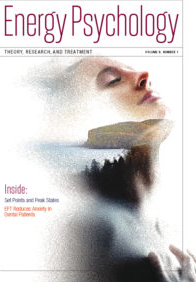New developments in scientific research and Access Bars ® approach. Having conducted a research project in neuroscience in Montreal for 1 year and a half in connection with spiritual hypnosis, this is a subject that interests me particularly. A new scientific research was conducted and published by Dr. Terrie Hope PhD, DNM, CFMW with a single Access Bars ® session of 90 minutes for each participant. A significant decrease in anxiety and depression was measured (decreased symptoms between 82 and 84%) after a single session.. The QEEG also shows an increase in brain coherence, i.e. communication between different regions of the brain, which is related to intelligence, learning abilities, vigilance, reaction time, creativity Etc These results suggest that Access Bars can be effective for anxiety and depression, and would also promote communication between different parts of the brain. This article and the results of the research below will soon be translated into French…. The text below is the Google translation of an original article that you  will find here « the effects of access bars on anxiety and depression: A pilot study doi 10.9769/EPJ.2017.9.2.TH Terrie Hope » Anxiety and depression are very That cause human suffering. The consequences for the individual include increased use of health care, disability and income reduction; Depression, at its current prevalence, also influences global economic output. Access bars, a non-invasive energy therapy technique, were evaluated for their effects on anxiety and depression using both subjective self-assessment measures and objective measurements of the brain. Methods: participants, N = 7, aged 25 to 68 years, had mild to severe anxiety and/or depression. The evaluation methods were standardized self-assessment measures: Beck Anxiety Inventory (BAI), Beck Depression Inventory-II (BDI II), State Trait Anxiety Inventory (STAI) and the Maryland State and depression (MTSD) scale. Electroencephalogram (EEG) data were acquired for the objective analysis of cerebral function via QEEG and SLORETA. Evaluations were performed prior to a 90-minute access bar session and immediately after the session. All participants were tested positive for stroke anxiety during the pretest. Results: Lower scores were reported in all self-assessment measures after the session. BAI average scores dropped from 23.3 to 3.6 (-84.7%), p = 0.004. The average scores for BDI II were reduced from 22.3 to 3.9 (-82.7%), p = 0.02. STAI-S (status) means decreased from 38.9 to 25.9 (-33.5%), p = 0.027. MTSD-S (state) averages were reduced from 23.6 to 4.7 (-80%), p = 0.015. Brain maps derived from QEEG results showed significant changes in frequency bands from 6 Hz (theta) to 21 Hz (Beta). These frequency bands in the pretest results showed extreme values of-3 to-1 standard deviations (SD) below the norm and changed to normal in the post-test results. QEEG FFT (Fast Fourier transform) T-tests showed improved coherence QEEG, p<0,05.></0,05.> Conclusion: Treatment with access bars was associated with a significant decrease in the severity of symptoms of anxiety and depression and an increase in the coherence of the EEG. These results suggest that access bars can be useful as a treatment for anxiety and depression. Neuroscientist Dr. Jeffrey Fannin has embarked on an analysis of what is happening in the brain before and after a session of Bars ® He was blown away (see video). Here is more information on research conducted in the USA from 80 to 120 participants: see here you can also see the video
will find here « the effects of access bars on anxiety and depression: A pilot study doi 10.9769/EPJ.2017.9.2.TH Terrie Hope » Anxiety and depression are very That cause human suffering. The consequences for the individual include increased use of health care, disability and income reduction; Depression, at its current prevalence, also influences global economic output. Access bars, a non-invasive energy therapy technique, were evaluated for their effects on anxiety and depression using both subjective self-assessment measures and objective measurements of the brain. Methods: participants, N = 7, aged 25 to 68 years, had mild to severe anxiety and/or depression. The evaluation methods were standardized self-assessment measures: Beck Anxiety Inventory (BAI), Beck Depression Inventory-II (BDI II), State Trait Anxiety Inventory (STAI) and the Maryland State and depression (MTSD) scale. Electroencephalogram (EEG) data were acquired for the objective analysis of cerebral function via QEEG and SLORETA. Evaluations were performed prior to a 90-minute access bar session and immediately after the session. All participants were tested positive for stroke anxiety during the pretest. Results: Lower scores were reported in all self-assessment measures after the session. BAI average scores dropped from 23.3 to 3.6 (-84.7%), p = 0.004. The average scores for BDI II were reduced from 22.3 to 3.9 (-82.7%), p = 0.02. STAI-S (status) means decreased from 38.9 to 25.9 (-33.5%), p = 0.027. MTSD-S (state) averages were reduced from 23.6 to 4.7 (-80%), p = 0.015. Brain maps derived from QEEG results showed significant changes in frequency bands from 6 Hz (theta) to 21 Hz (Beta). These frequency bands in the pretest results showed extreme values of-3 to-1 standard deviations (SD) below the norm and changed to normal in the post-test results. QEEG FFT (Fast Fourier transform) T-tests showed improved coherence QEEG, p<0,05.></0,05.> Conclusion: Treatment with access bars was associated with a significant decrease in the severity of symptoms of anxiety and depression and an increase in the coherence of the EEG. These results suggest that access bars can be useful as a treatment for anxiety and depression. Neuroscientist Dr. Jeffrey Fannin has embarked on an analysis of what is happening in the brain before and after a session of Bars ® He was blown away (see video). Here is more information on research conducted in the USA from 80 to 120 participants: see here you can also see the video